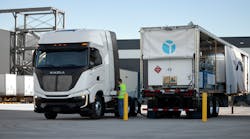As we move into the autumn months, many fleets across North America will begin to turn their attention to the challenges posed by winter and the extremely cold conditions they will face.
Throughout the year, engine lubrication is crucial for fleets. Lubricants enhance engine performance and protection by minimizing metal-to-metal contact between moving components, while reducing pumping and spinning losses. By doing this, engine lubricants can improve engine efficiency and fuel economy.
Impact of cold weather
In the cold weather, trucking operations are exposed to various stressful conditions, such as cold starts, that can have a negative effect on the wear rate of the engine. Taking longer to warm up in freezing conditions, the engine lubricant’s viscosity can be adversely affected and so can the protection it offers to the vehicle’s vital engine components. Lubricants are limited to optimal temperature ranges. When temperatures drop into the “critical” zone, the lubricant may stiffen or become overly viscous. The results can be damaging for machinery hardware as if it is improperly lubricated, and under these stressful conditions, equipment can seize up or even fail.
To address this, fleets should consider using a lower viscosity oil that will stay viscous and maintain its flow as temperatures decrease throughout the winter months. Lower viscosity lubricants are better suited to moving around machinery quicker, maintaining an adequate flow, in order to ensure vital components stay lubricated and protected. By utilizing the lowest viscosity grades accepted by the component OE ambient temperature requirements, the entire vehicle powertrain and hydraulic system can also operate with an improved efficiency.
Fleets have a business to manage and must ensure their vehicles are kept running, so it is important to choose the right heavy duty engine oil that meets seasonal demands, and the fleet’s operating conditions.
New engine oil specs
Since the biggest specification overhaul in the history of the North American heavy duty lubricant market, the introduction of API category CK-4 and FA-4 oils has gone even further to improve performance, durability and fuel economy. FA-4 oils, designed for 2017 and newer diesel engines, have a significantly lower viscosity, helping the engine to cope with extreme temperatures. This oil specification change is designed to create less friction in the engine and reduce fuel consumption, which can deliver improved fuel economy versus an SAE 15W-40.
Multi-grade oils such as SAE 15W-40 or 10W-30 are widely available and popular with fleets as they are able to operate both in extremely hot and cold temperatures. This allows fleets to stock just one product, rather than two. However, a fleet’s choice of lubricant should always be made after consulting the truck manufacturer on ambient temperature range recommendations as provided in the owner’s manual.
Just because temperatures are falling, doesn’t mean that equipment should be put at risk or that fleet operations should come to a halt during the winter months. The cold climate may pose a significant risk to machinery in the industry, but by choosing the appropriate lubricant, fleets can be sure that their assets and machinery remain in top operating condition and that their business can run as usual throughout the winter months.
It’s important for fleets to understand what happens to their lubricants in extreme conditions, because all engine lubricants have limits when it comes to operating temperatures. With a better understanding, fleets will have the foresight to select the appropriate lubricant for their operation, ensuring that their machinery is protected, whatever the weather. Additionally, by choosing an effective lubricant that complements the unique challenges of their operating conditions, fleets can maximize the performance of their heavy duty vehicles.
Brian Humphrey joined Petro-Canada Lubricants in 2013 as OEM Technical Liaison, HD Commercial Equipment Powertrain sectors, with responsibility for building the Petro-Canada Lubricants relationship with the North American heavy duty OEMs. His role is to gain a clear understanding of heavy duty equipment lubrication needs and specifications, and communicate those within the company to provide high value products and services to our mutual equipment end users. With over 35 years’ experience working for and with prominent companies across energy, transport, chemical and industry sectors, Humphrey has held senior R&D, engineering and sales services roles, and worked in international markets.



